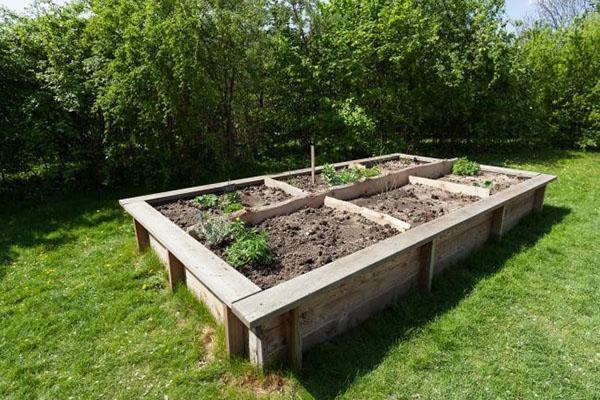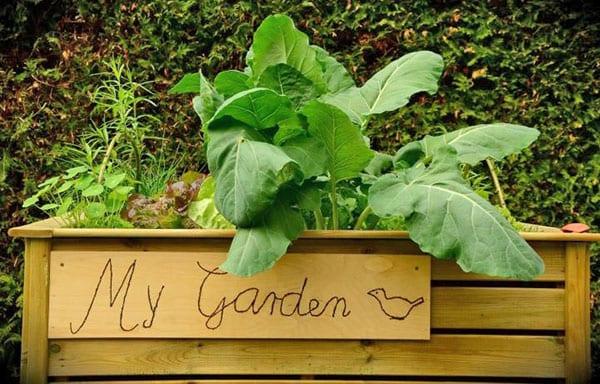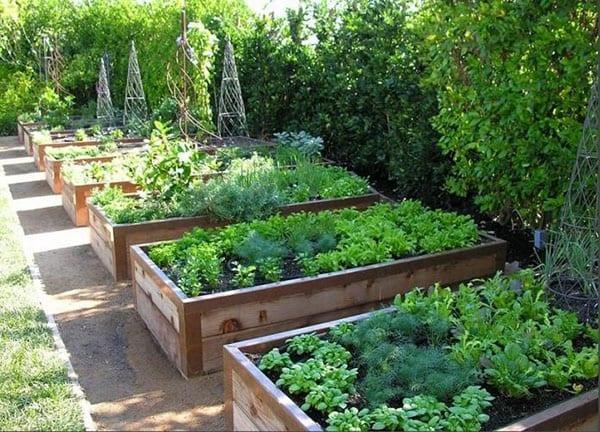How to make a raised bed with your own hands
 We want to share our personal experience and give recommendations on how to build a homemade garden bed in our yard. This does not require special skills and skill, and it is very easy to care for her.
We want to share our personal experience and give recommendations on how to build a homemade garden bed in our yard. This does not require special skills and skill, and it is very easy to care for her.
The benefits of a raised bed
This simple building will greatly simplify your suburban life:
- Ideal for a small area (as opposed to a garden in rows).
- Suitable for stony and poor soil.
- Compared to an ordinary vegetable garden, it produces more crops for the same area. This is due to better drainage and deep rooting of plants.
- Increases the growing season, since in cold regions, with the arrival of spring, you can start tillage earlier.
- Simplifies the gardening process. For example, a dense planting creates a shade (which acts as a mulch) to discourage weeds from growing.

Materials for building a raised bed
Many gardeners are concerned about the safety of the timber frame. First, remember that pressed wood impregnated with CCA family antiseptic should not be used. It releases arsenic. To increase the shelf life of a tree, there are several options:
- Today, mass production of pressed wood adds a mixture of chemicals to protect it from rotting due to moisture. Despite the fact that this type of wood is certified and safe for plants, some still doubt this and prefer to use alternative environmentally friendly materials.
- More expensive types of wood, such as cedar, contain natural oils that prevent decay, increasing the durability of the material. They are expensive, but they will last an order of magnitude longer.
- The thicker the board, the longer it will not rot. For example, a two-inch larch wall can stand for 10 years without any maintenance.
You can also use concrete blocks or bricks, but keep in mind that concrete increases the acidity of the soil over time.
Some even accommodate railroad ties, but I don't recommend doing that. If old samples can still fit, then in the manufacture of new ones, treatment with creosote is used, which is toxic.
Planning and dimensions
 Having decided on the type of wood, you can proceed to planning future construction:
Having decided on the type of wood, you can proceed to planning future construction:
- Choose a location that will receive sufficient sunlight.
- The standard bed width is 120 cm. This size provides unhindered access to plants without the need to step inside;
- the length of the structure is not critical. The sections are often made 120x240 cm or 120x360 cm.
- The depth may vary, however, it should be at least 15 cm. The roots require 15 to 30 cm, so the ideal depth is 30 cm.
- Before setting up the bed, make sure that the soil is not compressed. To do this, loosen it with a garden pitchfork to a depth of 15 - 20 cm. For better rooting, some gardeners remove the top layer of soil (to the depth of a shovel), then dig the next layer and mix with the first.
Raised bed construction
Place wooden posts in each corner to support the structure (and every 60 cm for long beds). I recommend doing this from the inside - this way the supports will be less noticeable.
The support posts must be dug in by about 60%, leaving the upper part above the ground.Make sure they are all the same height, otherwise the sections will be uneven.
Then place the bottom row of boards and check that they are all on the same level. After that, nail the rest. It is best to use galvanized nails or self-tapping screws.
In order to comfortably move between the beds, you should leave a passage of 60-70 cm.
Soil for filling
Fill the sections with a mixture of topsoil, compost, and other organic materials (such as manure) to keep the plants in a nutrient-rich environment.
Please note that the soil in such beds dries out faster, which is useful in spring and autumn. However, cover the topsoil with straw, mulch or hay in summer.
Frequent watering is essential for any elevated plant. This is especially true of the early stages of their growth in raised beds.
What plants can be planted
 Almost any crop can be grown in raised beds. Vegetables are the most common, but fruits, bushes and even trees are also successfully planted. Just remember that some plants will grow outside of their section and this should be considered when planning the location.
Almost any crop can be grown in raised beds. Vegetables are the most common, but fruits, bushes and even trees are also successfully planted. Just remember that some plants will grow outside of their section and this should be considered when planning the location.
Useful Tips
 A few general guidelines will help you maximize your vegetable garden.
A few general guidelines will help you maximize your vegetable garden.
Continuity. Replacing seedlings on time will ensure continuous production. When one crop is harvested, have ready-made seedlings to replant the old ones. For best results, use fast ripening varieties to maximize fruit in one season.
 Close fit. Plant different crops close together to save space. Plants should be at such a distance that their leaves are in contact with each other, blocking the earth from the sun's rays. This will prevent weeds and retain moisture, eliminating the need to water, weed, and mulch frequently. Since the plants, as they ripen, will press against each other, collect the early ripening ones first, leaving others room for full development. For example, combine lettuce leaves with seasonal vegetables such as tomatoes, broccoli, or peppers.
Close fit. Plant different crops close together to save space. Plants should be at such a distance that their leaves are in contact with each other, blocking the earth from the sun's rays. This will prevent weeds and retain moisture, eliminating the need to water, weed, and mulch frequently. Since the plants, as they ripen, will press against each other, collect the early ripening ones first, leaving others room for full development. For example, combine lettuce leaves with seasonal vegetables such as tomatoes, broccoli, or peppers.
 Different cultures are allies, not rivals. Plants have different root lengths. Planting them side by side is the key to making the best use of the entire garden. For example, you can combine beans with short roots and beets that are deeply rooted. Thus, you exclude competition between cultures. It is also beneficial to plant vegetables that are demanding on the amount of nutrients (cabbage, cucumbers) along with beans or carrots that are unpretentious in this regard.
Different cultures are allies, not rivals. Plants have different root lengths. Planting them side by side is the key to making the best use of the entire garden. For example, you can combine beans with short roots and beets that are deeply rooted. Thus, you exclude competition between cultures. It is also beneficial to plant vegetables that are demanding on the amount of nutrients (cabbage, cucumbers) along with beans or carrots that are unpretentious in this regard.
Help grow. If there is a fence on the north side of the bed, then the tallest plants planted there will not cast a shadow on the rest. Do not let climbing varieties grow randomly, taking up valuable space. Help them grow in the right direction:
- Cucumbers willingly climb up the trellised fence. As a result, the hanging fruit is very easy to pick.
- Tomatoes ripen faster and produce more tomatoes if they are above the ground, tied to a support.
- Peas and beans always reach for the sky. Place a tripod or wire mesh and they will begin to wrap around it.
Some heavy plants, like melons and watermelons, will need help with directional growth. Tie their shoots to a support to make them move in the right direction. Support large fruits with straps so that they do not come off and do not fall prematurely.
 Nutritious soil, sufficient sun and good drainage are all necessary conditions for the successful development of a vegetable garden. Create your own garden that will always delight you and your friends with fresh vegetables and fruits to the table.
Nutritious soil, sufficient sun and good drainage are all necessary conditions for the successful development of a vegetable garden. Create your own garden that will always delight you and your friends with fresh vegetables and fruits to the table.